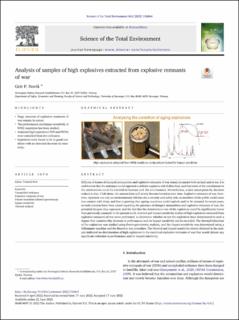| dc.contributor.author | Novik, Geir Petter | |
| dc.date.accessioned | 2022-09-02T13:22:42Z | |
| dc.date.available | 2022-09-02T13:22:42Z | |
| dc.date.created | 2022-08-29T13:08:56Z | |
| dc.date.issued | 2022 | |
| dc.identifier.citation | Novik, G.P. (2022) Analysis of samples of high explosives extracted from explosive remnants of war. Science of the Total Environment, 842, 156864. | en_US |
| dc.identifier.issn | 0048-9697 | |
| dc.identifier.uri | https://hdl.handle.net/11250/3015458 | |
| dc.description.abstract | Millions of tonnes of dumped ammunition and explosive remnants of war remain in nature both on land and at sea. It is well known that the ordnance could represent a definite explosive risk if disturbed, and that some of the constituents in the ammunition could be harmful to humans and the environment. Nevertheless, a tacit assumption by decision makers is that, if left alone, the ammunition will slowly become harmless over time. Explosive remnants of war, however, represent not only an environmental risk but also a security and safety risk, as members of the public could come into contact with them, and fear is growing that ageing munitions could explode and/or be misused. In recent years, several concerns have been raised regarding the presence of dumped ammunition and explosive remnants of war, the potential dangers they represent, and the fact that the deterioration rate of the explosives could be significantly lower than previously assumed. In the present work, thermal and impact sensitivity studies of high explosives extracted from explosive remnants of war were performed, to determine whether or not the explosives have deteriorated to such a degree that a noteworthy decrease in performance and/or impact sensitivity can be recorded. The thermal behaviour of the explosives was studied using thermogravimetry analysis, and the impact sensitivity was determined using a fallhammer machine and the Bruceton test procedure. The thermal and impact sensitivity results obtained in the analysis indicated no deterioration of high explosives in the examined explosive remnants of war that would denote any significant reduction in performance and/or impact sensitivity. | en_US |
| dc.language.iso | eng | en_US |
| dc.rights | Navngivelse 4.0 Internasjonal | * |
| dc.rights.uri | http://creativecommons.org/licenses/by/4.0/deed.no | * |
| dc.subject | eksplosiver | en_US |
| dc.subject | krigsrester | en_US |
| dc.title | Analysis of samples of high explosives extracted from explosive remnants of war | en_US |
| dc.type | Peer reviewed | en_US |
| dc.type | Journal article | en_US |
| dc.description.version | publishedVersion | en_US |
| dc.rights.holder | © 2022 The Author. | en_US |
| dc.subject.nsi | VDP::Teknologi: 500 | en_US |
| dc.source.pagenumber | 0 | en_US |
| dc.source.volume | 842 | en_US |
| dc.source.journal | Science of the Total Environment | en_US |
| dc.identifier.doi | 10.1016/j.scitotenv.2022.156864 | |
| dc.identifier.cristin | 2046718 | |
| dc.source.articlenumber | 156864 | en_US |
| cristin.ispublished | true | |
| cristin.fulltext | original | |
| cristin.qualitycode | 2 | |

